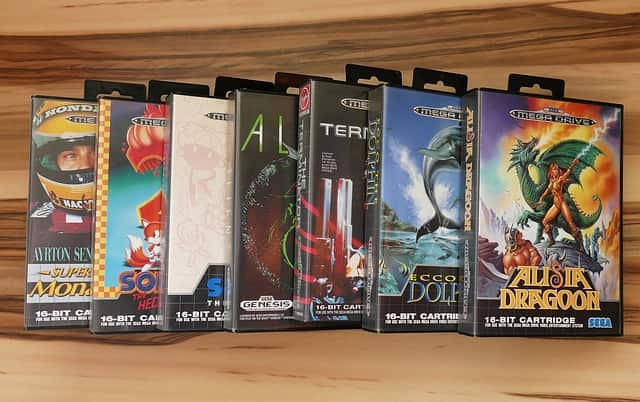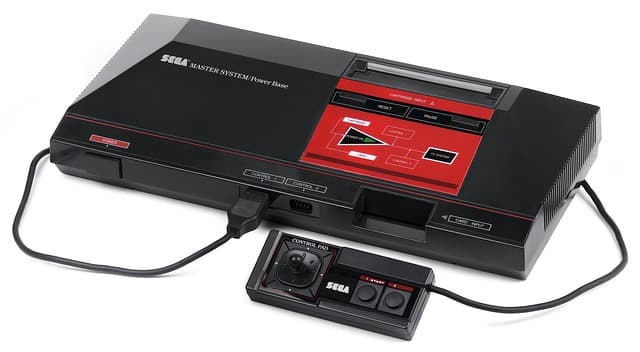The gaming industry emerged almost simultaneously in the US and Japan. Back in the 1950s, Sega and Nintendo were formed, producing only children’s toys at the time. But the games themselves originated in the US as a university experiment. In 1947, two inventors Thomas Goldsmith Jr. and Estle Ray Mann filed a patent for registration of an entertainment device equipped with a CRT tube and buttons that allowed you to aim the point of aim at schematic figures of aircraft. And, up until 1962 (when Spacewar came out), various universities conducted research in a field that can very conventionally be called a game.
Despite the fact that such experiments are not known in Japan, corporations like Nintendo, knowing how to work with children’s audiences and knowing the local market well, got hold of the new technology and very quickly got to grips with the new industry. Ralph Baer, called “Thomas Edison of video games”, in 1966, while working for Sanders Associates, worked with Bill Harrison to develop the “Brown Box”, the first prototype home console, from which Atari’s first home console grew. In 1971, the “Brown Box” was reworked and renamed Magnavox and later became Magnavox Odyssey, which was released in 1972. Also in 1972, the freshly formed Atari released their famous Pong, designed by Alan Alcorn and Nolan Bushnell, on arcade machines, which was the first success of the company and arcade machines in general. Odessey sold 100,000 copies in just its first year.
Having found a gold mine, Atari in 1974 decided to release a new game every month. Bushnell’s strategy involved cloning his own games – Dr. Pong, Pong Doubles, and QuadraPong. Other companies also appreciated the approach and began to churn out endless clones of sports games like Handball and Hockey. That’s when the first text-based games like the Dungeons & Dragons – Adventure (1976) adaptation appeared. This involved a huge number of economic agents – shopping malls organizing game rooms, delivery services, publishers producing all sorts of paperbacks based on the motifs, etc. All of them were dependent on the release of more and more games as this was the only way to keep the wheel of Sansara turning and no one wanted to find ways to regulate production within the established system. All the more so in 1978, Space Invaders came out, and in 1980, the new console from Atari, sold out in the millions. “Strike while the iron is hot”, as the saying goes. The day was approaching when supply would outstrip demand, and a crisis would inevitably follow. And so it was.
The situation was somewhat different in Japan. The first slot machine game was released in July 1973, and it was Atari’s Pong. Japanese giants such as Taito and Sega went on to produce clones of the famous bestseller that were, very originally, called Elepong and Pong Tron. Founded in 1955, Nakamura Manufacturing Corporation (Namco) also signed an agreement with Atari in 1973 to become its official distributor in Japan. And the success of Space Invaders in 1978 was such that it caused a shortage of 100-yen coins in the country. Other developers immediately began releasing clones of Space Invaders.
In 1977 Nintendo released their most popular console to date, the Color TV Game, followed by the Sord M200 in 1977 and the Sharp MZ-80K in 1978. Following Nintendo, Konami, Data East, Irem, SNK, Nichibutsu, Sunsoft, Jaleco, Tecmo, Capcom to name a few. And anyway, arcade machines have been more popular than consoles in Japan for quite a long time. This can be explained by the collectivist mentality of the Japanese at the time. In the period from 1975 to 1983 it was released 125 consoles and by the end of the 1970s, rapidly growing industry has covered a wave of overproduction. Only Sega, Nintendo and a couple of smaller companies remained. Even the popularity of arcade machines declined in 1982. Donkey Kong (1982) – 50,000 arcade machines, Donkey Kong 3 (1983) – 5,000 machines.
In the US, the period from the late 1970s to the early 1980s was dubbed the “Golden Era of video games” (it was when a huge number of concepts and ideas were born that propelled the industry for the next decade), the US was preparing for the worst.
“Unfortunately, most distributors expected too much sales and ended up with very high debts.”
- Eddie Adlum, editor of Replay magazine
Many, in the hope that business would continue to grow, opened huge arcade complexes: Castle Park in Riverside, California, for example. Many of these complexes opened in the early 1980s, when the industry was at its peak, and then went bankrupt almost instantly, losing their main source of games – Atari. The same fate befell many distributors and other corporations tied to the gaming industry.
In 1982, Atari said it expected sales growth of 10-15% in the first quarter of the year. All analysts were in silent shock when Warner Communications shares plummeted 16% after the close of the New York Stock Exchange on 8 December. The entire US gaming industry began to collapse. Even revenues from older games could not cover the losses. Millions of cartridges were simply returned to the manufacturer by the shops. Players interest in games finally collapsed and a year ago the flourishing industry became a black hole for investors. In 1983, the $3.2 billion industry plummeted to $100 million.
Nintendo in 1983 released its legendary Nintendo Entertainment System or simply the NES. Taking advantage of the momentum on both sides of the Pacific, it quickly took over 90% of the market, securing a monopoly for the next 10 years.
The release of the NES heralded a new set of rules for the game. Before NES, developers were free to develop games for any console and all they had to do was buy special hardware. The NES had a special 10NES authorisation chip. If the console chip couldn’t detect the chip in the cartridge, the game wouldn’t run. Developers had to get permission from Nintendo to develop each game. Developers were also forbidden to work for other companies. And games on other consoles were not allowed to be released until 2 years after the release on the NES.
Nintendo started releasing a hundred games a year while other companies could only count on a dozen. When Nintendo took over 90% of the market, fixed prices were set. And even though the cost of production was falling, prices didn’t think to fall. Basically, all the charms of any monopoly. The launch of the NES/Famicon in Japan was so significant that Japanese director Osamu Katayama compared it to the opening of Disneyland in Tokyo (which opened at the same time as the NES). This proved to be a crucial factor in the development of culture in Japan and society as a whole. The incredible success of the NES, first in Japan and later in the rest of the world, led to some ingenious business decisions.
Nintendo focused primarily on children and, if possible, parents. In order to extract more money from the pockets of the whole family, Nintendo developed an entire production and consumption infrastructure around the world, Nintendo World, which organised tournaments, sold merchandise, created interconnected fan clubs of over 250 establishments, not to mention selling the consoles and games for them themselves.
The same thing was happening to the American industry. New technology provided access to new opportunities. The success of the NES and its dominance in the mid-1980s shifted the attention of developers wishing to remain independent to the PC. When Japan experienced a video game boom in the second half of the 1980s, personal computers also began to be reoriented towards games. Japanese PC games were distributed at various trade shows like Comic Market, mailed out and so on. This was a way of distributing dating sims, girl games, visual novels, and RPGs.
The game production strategy in Japan was not very different from the western games. After the success of a particular mechanic, others start copying it. Some successfully, some not so much. As we have already seen, the monotonous console glut in the 1970s in Japan almost brought down the market, and did so in the US. But now everything was already divided, and the major players were well aware of the specifics of the market and the risks involved. Medium-sized projects simply could not sell as many copies as AAA games. They were not provided with the same kind of advertising and media coverage and produced fewer cartridges.

Europe was well behind the USA in the field of interactive entertainment. Although with Magnavox Odyssey and Pong Europeans have been known since 1973. That was also when the first consoles began to be released: the British Videogame Home T.V. and the Italian Ping-O-Tronic. In 1978 the Interton VC-4000 (an analogue of the Atari VCS 2600) was released in Germany. But these duds could not compete with the American consoles. On the PC market, no sensible alternative to the American Apple II, Commodore PET or TRS-80 was even seen. At the same time, games were not taken seriously and were advertised purely as a feature of the PC. Indeed, this was also why the console giants were in no hurry to take over the market on the other side of the Atlantic, especially when theirs was still untapped and on the verge of collapse.
And in 1982, the famous ZX Spectrum was released in the UK and elsewhere, best selling the Commodore 64 and becoming the best selling PC in the world. It was also when a truly mass-produced, albeit artisanal, games began to be produced. English developers went into utter surrealism, releasing platformers about killer toilets. The intensity of the absurdity was such that there was a serious discussion in the press about drug addiction among developers, analogous to the proliferation of drugs among British musicians. The energy of the British market was a powerful growth factor for the video game industries in Spain and Australia, which targeted the English market. Spain’s main exports were military games such as Army Moves, inspired by Rambo, and heist games like Goody, while Australians mostly produced text-based quests based on J.R.R. Tolkien’s The Hobbit. J.R.R. Tolkien. In 1982 alone, there were 226 games made in the UK for the Spectrum. In 1983 that number had risen to 1,188 and the number of companies producing them rose from 95 to 458.
The French games industry differed from the British in its attempts to speak seriously, bringing interactive entertainment on a par with films and books in terms of emotional impact. But, on the whole, the industry was very slow to develop. The popular magazine Tilt wrote in 1984 that French games tended to create something closer to French reality, bearing the imprint of the personalities of their creators.
Since the Second World War, Germany had been hit by severe censorship, so foreign games were constantly blacklisted. And for a few years they were comfortable on their own. Until the Netherlands put a big pig under the whole industry by becoming the European centre of piracy. There were no laws on intellectual property in games and the only way to influence the pirates was to use kind words and prayers. Which did not bother them much as they saw it not only as a way of earning money but also as a challenge to their own skills and creativity.
And if no one pays for the goods, no one will produce them. All the more so, the rise in piracy came just at a time when budgets and the production cycle of every game were rising. In 1984 alone, 474 studios closed in the UK and by 1989 there were only 101. In other countries it was even worse. What was left was either all sorts of minnows or big corporations from Europe gaining strength like Ubisoft. Pirates cleared the way for Japanese and American companies like EA, not to mention the giants like Sega, Nintendo and Sony who joined them in the mid-1990s and Microsoft five years later. Very quickly the games industry became an international phenomenon, with all the major corporations operating all over the world.
While national industries had formed by the mid-1980s, by the 1990s they had overcome this insularity by absorbing the more backward and less agile neighbours. Two world centres of gaming have emerged: Japan with all of Asia (China, Korea, Taiwan) and the United States (Euro-Atlantic region). And at this point it was cultural differences that acted as a brake on further globalisation of the industry and bringing it to a single standard. But in Europe, this standard, as well as the largest market for sales and production, was called “USA”, and in the East “Japan” and then “China”.
But there were also different processes going on within the US. In the late 1980s, major studios like Lucas Arts, not wanting to play by the rules set by Nintendo, left for the PC. And while consoles were fully satisfied with 16-bit, the PC began to make wide use of VGA and then SVGA: showing 256 colours instead of 16 – thus raising the quality of graphics immensely. The inertia of consoles, in this respect, ensured that the PC had an advantage in the 1990s. There were still entire exclusive genres out there: quests, shooters, strategies. These were extremely difficult to adapt to consoles with gamepads without sticks.
After the PlayStation One and other 5th generation releases in the latter half of the 1990s, 3D began its victorious march across all genres and platforms. As the scale of games increased, so did budgets, and studios required more and more skilled personnel, which increased wages and increased the appeal of video games for many talented people. But failure now also meant huge financial losses. Inevitably the dependence of large and not so large corporations on banks, which at first only gave loans, but soon became investors, who laid out their terms to maximize profits, increased. At the same time, the main problem of PCs – various hardware, operating systems (up until the 2000s, many were sitting under DOS) and software – also came out.


